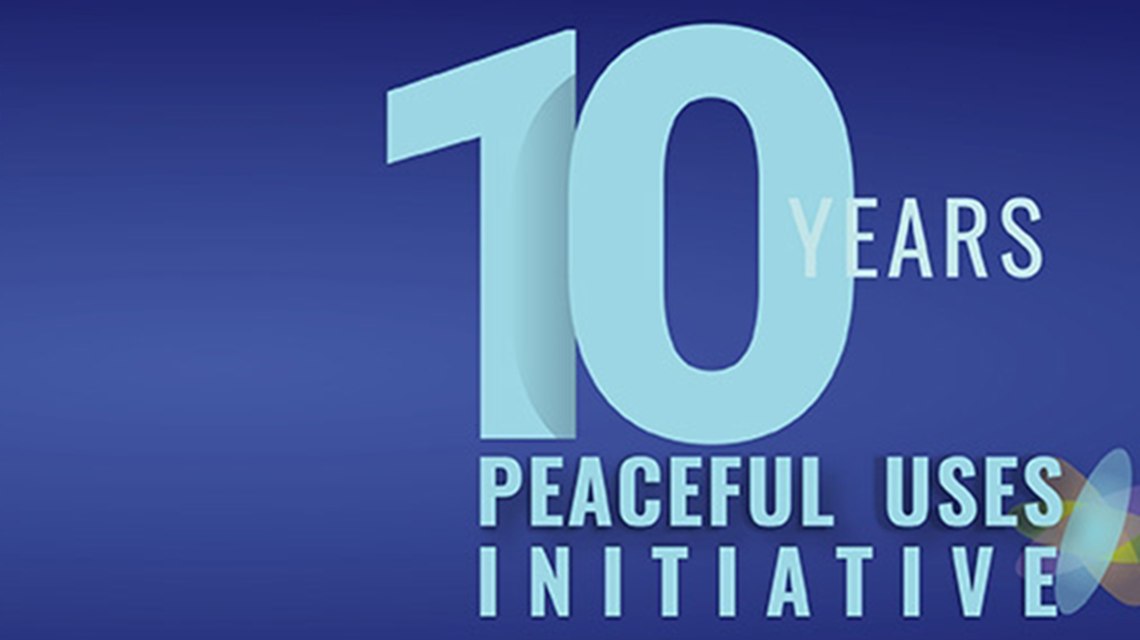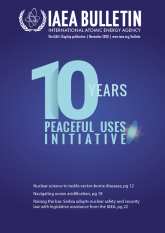
If you would like to learn more about the IAEA’s work, sign up for our weekly updates containing our most important news, multimedia and more.
Ten Years of the IAEA Peaceful Uses Initiative
Shota Kamishima

This year marks the tenth anniversary of the Peaceful Uses Initiative (PUI). The inception of the PUI can be traced back to the 2010 Review Conference of the Parties to the Treaty on the Non-Proliferation of Nuclear Weapons (NPT), where it was proposed by the delegation of the United States of America. Later that year, the PUI was established as a funding initiative to support IAEA projects on the peaceful uses of nuclear technology. It has since become instrumental in mobilizing extrabudgetary contributions to support unfunded IAEA activities, including technical cooperation projects, that further the peaceful application of nuclear technology.
Since 2010, the annual resolutions of the IAEA General Conference have encouraged all Member States in a position to do so to make additional contributions to the PUI. As of 30 September 2020, 24 countries and the European Commission have donated through the PUI and provided €174 million in financial contributions. In 2017, funding to the PUI expanded to the private sector, and Shimadzu Corporation became the first company to contribute. These contributions have supported over 300 projects benefitting more than 150 Member States.
Several Member States have pledged multi-year funding to the PUI. Now funding can be relied upon with greater predictability, which is particularly beneficial for long-term, large-scale projects and has enabled the IAEA to respond quickly and flexibly to emergencies and the evolving and emerging priorities of Member States. This has been demonstrated by the IAEA’s response to the Ebola virus disease in West Africa, to the Zika virus disease in Latin America and the Caribbean, and to natural disasters in Asia and Latin America. Most recently, funding received through the PUI has supported the IAEA in its efforts to assist Member States in combating COVID-19, delivering consignments of equipment for virus detection and diagnosis, accessories, personal protective equipment and other supplies.
PUI funding has contributed to projects in a variety of areas, including food security, water resource management, human and animal health, nuclear power infrastructure development, and nuclear and radiation safety, many of which would have remained unfunded without the PUI. The figure on the below shows the allocation of funds received through the PUI broken down by thematic area.

Those featured in this edition are just a few examples of the projects that have benefited from the PUI over the past ten years.
The area of nuclear power and fuel cycle has received more PUI funding than any other thematic area. The IAEA assists Member States considering, planning or starting the introduction of nuclear power in developing their programmes, including the establishment of the necessary safety infrastructure. Funding received through the PUI has financed a number of Integrated Nuclear Infrastructure Review (INIR) missions as well as capacity building projects. The PUI has also supported an Internet Reactor Laboratory project, giving university classrooms access to research reactor experiments via live online broadcasts. It has also supported INIR for Research Reactors (INIR-RR) missions.
The modernization of the IAEA’s nuclear applications laboratories at Seibersdorf, Austria, is one of the most important projects ever undertaken by the IAEA. The services and infrastructure that the laboratories can provide to Member States in the years to come have been significantly enhanced and expanded. As of October 2020, the PUI accounts for 35 per cent of the total amount of extrabudgetary contributions received for these projects. (For more details, see our article here.)
In the area of food and agriculture, a PUI-sponsored drip irrigation project in Sudan helped women farmers, with the aid of nuclear technology, to increase food yields while optimizing the use of water and fertilizer. The PUI played an important role in establishing the Veterinary Diagnostic Laboratory (VETLAB) Network, a network of animal health laboratories intended to diagnose and monitor diseases. Building on the VETLAB Network, the IAEA contributes to the global effort to eradicate peste des petits ruminants (PPR), which kills thousands of sheep and goats every year in Africa, the Middle East and Asia (read more here). The PUI has also funded a project in Senegal to promote the use of the sterile insect technique (SIT). As a result, the tsetse fly population in target areas north-east of the capital Dakar has significantly reduced, improving farmers’ livelihoods.
In the area of human health, many low- and middle-income countries have benefited from IAEA imPACT review missions that have been financed by the PUI and which assess national cancer control capacities and needs, and recommend how best to prioritize related activities and investment. The PUI has also supported a project that helps Member States in Latin America and the Caribbean to access nuclear medicine for early and accurate diagnosis of cardiovascular diseases and cancer, providing support in purchasing equipment, face-to-face training for specialized skills and carrying out expert missions to raise awareness of radiation safety among health care practitioners and decision makers of the clinical applications of nuclear medicine.
In the area of water and the environment, PUI funding has supported a project to help 13 countries in Africa’s drought-prone Sahel region use isotopic techniques to assess groundwater origin and quality, resulting in the first broad overview of the region’s groundwater supplies. Thanks to the PUI, Member States in Asia and the Pacific, with the use of nuclear techniques, have strengthened their capacity to monitor harmful algal blooms and reduce their adverse impacts on seafood safety. Likewise with the help of the PUI, the Ocean Acidification International Coordination Centre (OA-ICC) was launched at the United Nations Conference on Sustainable Development (Rio+20) in 2012 and continues to collaborate with partners across the globe to further the scientific study of ocean acidification and to advance international collaboration (read more here).
In the area of nuclear safety, the PUI has supported a project in Central Asia to enhance coordination among organizations working toward remediation and safe regulatory control of former uranium mining and processing legacy sites. The PUI has also assisted Member States in sustaining the control of radioactive sources throughout their life cycle and in enhancing capacity to manage these sources, both while in use and thereafter, according to international safety standards and best practices. The PUI also supported a project focused on assisting Member States with the development and application of safety regimes for radioactive waste and spent fuel management.


